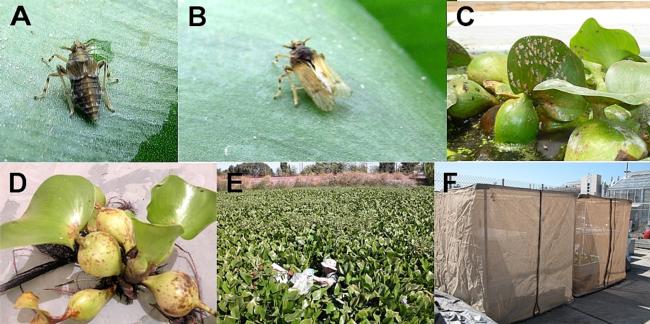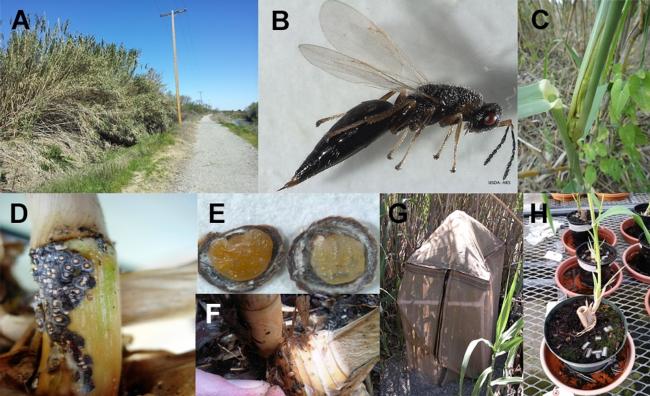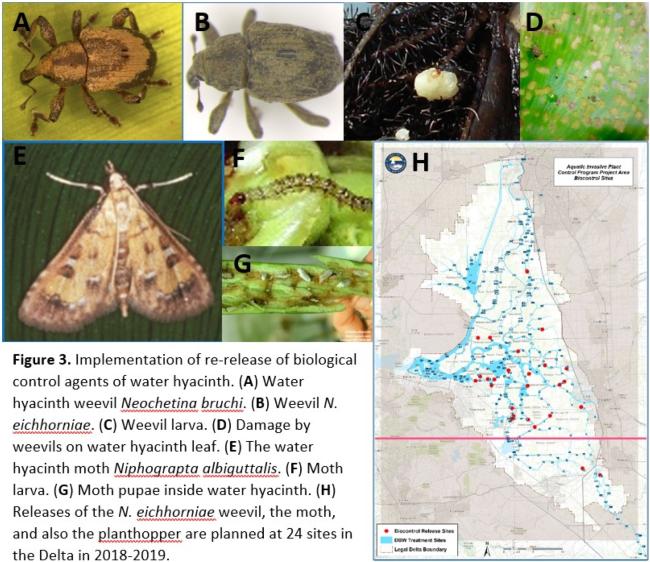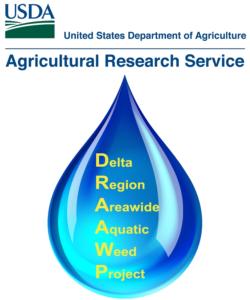Areawide Release, Evaluation and Implementation of New Biological Control Agents for Control of Water Hyacinth and Arundo
Objectives
1. Release the leaf-feeding water hyacinth planthopper for biological control of water hyacinth at up to 30 sites in the Sacramento-San Joaquin Delta and its upstream river watersheds.
2. Re-release the leaf-chewing and stem-boring weevil Neochetina eichhorniae and the leaf-boring moth Niphograpta albiguttalis in the Delta.
3. Release the shoot tip-galling arundo wasp and the root- and shoot-feeding arundo armored scale at up to 15 sites in the Sacramento-San Joaquin Delta and its upstream river watersheds.
4. Verify successful establishment of the biological control agents.
5. Verify that biological control can be integrated with aquatic weed control with herbicides and mechanical removal to reduce the size, reproduction, and spread of water hyacinth and arundo.
Background
Water hyacinth (Eichhornia crassipes), a floating aquatic invasive weed, covers up to 10,000 acres in the Sacramento-San Joaquin Delta, including areas that are inaccessible or impractical for herbicide treatment and mechanical removal. Water hyacinth blocks water flow for pumping intakes, impedes recreational and commercial navigation and creates danger for boats, alters water quality for fish, blocks light for submersed plants and displaces native aquatic plant and animal species.
To implement adaptive, integrated management under the DRAAWP, selection of sites at which specific types of weed control strategies will be emphasized is critical. Selection of sites for water hyacinth biological control is being informed by several sources of information, including:
- Remote sensing of water hyacinth populations using Landsat satellite and airplane-borne systems. DRAAWP project partners from NASA-Ames have developed an automated processing tool to determine acreage of water hyacinth from Landsat images. Analysis of images over the past several years has revealed backwaters, such as flooded islands, where water hyacinth populations persist in spite of nearby control. These sites act as ‘nurseries’ for new populations to develop each year. These ‘backwater nursery’ sites are well-suited for biocontrol, as the stable water hyacinth populations will permit development of large populations of biocontrol agents.
- The detailed knowledge of field operations managers with the Division of Boating and Waterways-California Department of Parks and Recreation, a DRAAWP project partner, who can identify sites at which persistent water hyacinth populations are difficult to control using other methods.
- Information from the San Joaquin and Contra Costa Mosquito and Vector Control Districts, both DRAAWP project partner, who have identified sites, often in non-navigable places and therefore not subject to herbicidal control, at which persistent water hyacinth populations are creating a health hazard by harboring mosquitos.
Arundo (Arundo donax), a giant grass up to 25 ft tall, grows along the edges of sloughs and canals in the Sacramento-San Joaquin Delta, and is also abundant in the Sacramento and San Joaquin River watersheds. Arundo blocks access to water, consumes/wastes water, obstructs flood control channels, creates fire hazards along sloughs and rivers, and displaces native plants.
Site selection for biological control of arundo is being informed by the Sacramento-San Joaquin Delta Conservancy, a DRAAWP project collaborator. The SSJDC has mapped arundo populations in the Delta using both satellite images and ground-level surveys. They have also prioritized sites for integrated chemical-physical-biological control using a restoration prioritization model.
Approaches
One New Biological Control Agent for Water Hyacinth
As part of the DRAAWP, an integrated, adaptive management plan for water hyacinth is being implemented, including the release and evaluation of a new biological control agent. The USDA-Agricultural Research Service (ARS) in Florida had previously discovered and determined the host range, biology and impact of a planthopper, Megamelus scutellaris, from the South American native range. Releases in California began in 2011 by CDFA, and in 2012 the USDA-ARS Exotic and Invasive Weeds Research Unit in Albany, CA assumed responsibility for field releases. The planthopper adults have both a short-winged form (Figure 1A), which cannot fly but can hop tens of times its small size (less than 1/16th of an inch), and a long-winged form which can fly (Figure 1B). Adult females lay eggs on the undersides of water hyacinth leaf blades and petioles (the stalks supporting the leaves). Eggs hatch in a week or less and complete five immature stages in about a month, then molt to the adult stage. Under warm conditions, the planthopper can build up large populations, over 100 insects per leaf, in just a few months (Figure 1C). Immatures and adults damage water hyacinth leaves by puncturing tissues and feeding on plant juices (Figure 1D), and heavy feeding can kill water hyacinth plants. Field releases are made by placing infested plants into field sites, and up to 20,000 planthoppers are released at each site. Repeated visits by wading or from a boat are needed to evaluate the establishment and impact of the planthopper (Figure 1E). Planthoppers are being mass-reared in six colony cages (Figure 1F), including two at the USDA-ARS in Albany, and four at collaborating agencies on the DRAAWP: two at the Contra Costa Mosquito and Vector Control District in Concord, one at the San Joaquin Mosquito and Vector Control District in Stockton, and one at the California Department of Food and Agriculture in Sacramento. Biocontrol with this planthopper is expected to reduce the ability of plants to reproduce via budding early in the season and reduce the size of mature plants. Both of these effects are expected to make integrated control of water hyacinth easier and less expensive.
Figure 1. Implementation of biological control of water hyacinth using the water hyacinth planthopper Megamelus scutellaris (A-C), damage caused by developing populations on water hyacinth (D), release and evaluation (E), and rearing of planthoppers for additional releases (F).

Photo Credits. A: Seth Johnson/LSU Ag Ctr. B: Mike Ferro/USACE. C: Baldo Villegas/CDFA. D-E: Patrick Moran/USDA-ARS.
Two New Biological Control Agents for Arundo
Two biological control agents were discovered and verified as safe for release in the U.S by the USDA-ARS in Texas. Since 2014, they have been released on populations of arundo in the Sacramento-San Joaquin Delta. Arundo thickets are common on slough levees in the Delta (Figure 2A). The arundo wasp Tetramesa romana (about ¼ inch in length) makes galls in the shoot tips of main and lateral shoots of arundo. Females (Figure 2B) reproduce without mating, and 90% of the population is female. Females live three to five days and can each produce about 25 offspring. The females inject eggs into shoot tips. Eggs hatch after 5-7 days and a gall or ‘tumor’ develops at the shoot tip (Figure 2C). Larvae feed on the gall tissue through three immature stages, pupate, and emerge as new adults within 4 to 6 weeks of egg hatch to repeat the life cycle. At least four generations per year can be produced under warm conditions. Along the Rio Grande in south Texas, five years after release, the arundo wasp has decreased arundo biomass by 20%, by killing lateral shoots and some main shoots, and slowing their growth. So far, the arundo wasp has been released at five sites in the Delta: Big Break; the Sacramento River bank on Andrus Island; and the bank of Middle River on Lower Jones Tract. The arundo armored scale insect Rhizaspidiotus donacis feeds on stems and roots of arundo. Immobile adult females (only 1/16th of an inch across) (Figure 2D, 2E) produce tiny mobile ‘crawlers’ that disperse and settle on shoot buds, then lose their legs and antennae. The scales complete an additional immature stage. Short-lived winged males then emerge and mate with the female scales, which continue to feed and develop the next generation of crawlers. The life cycle takes 4 to 6 months, and two generations per year can be produced in California. At the first release sites in Texas, the scale is reducing new shoot development, and similar impacts are expected in California, where establishment has been confirmed at one site in the Sacramento River Valley (Figure 2F). Releases in the Delta so far have occurred only at Big Break. Many additional releases of both of the arundo agents will occur in 2016. Release technology for the arundo biocontrol agents includes small field cages to increase wasp egg-laying on young shoots (Figure 2G), and release of arundo armored scale crawlers on arundo ‘microplants’, grown from small shoot buds in the greenhouse (Figure 2H). Six months after initiating microplants indoors, they can be taken to field sites and the next generation of crawlers will disperse onto resident arundo plants.
Figure 2. Implementation of biological control of arundo using the arundo wasp Tetramesa romana and the arundo armored scale Rhizaspidiotus donacis. Thickets of arundo along slough levees (A) are being targeted for control. The arundo wasp (B) lays eggs in and galls shoot tips (C). The arundo wasp is established near Big Break in the western Delta. The arundo armored scale forms aggregations on shoot buds and roots (D). Adult females turn from yellow to orange as they mature and develop crawlers (E). The scale is established at one site in the Northern Sacramento Valley (F). Small field cages can be used to increase wasp egg-laying on young arundo shoots (G). Potted ‘microplants’ are infested with arundo armored scales (H), then placed at field sites so the next generation of crawlers can disperse to resident arundo plants.

Photo Credits. A, G, H: Patrick Moran/USDA-ARS. B, E: Crystal Salinas/USDA-ARS. D, F: John Goolsby/USDA-ARS.
Permission Obtained for Delta Releases on Water Hyacinth
In early 2018, the USDA-ARS and Division of Boating and Waterways-CA Parks obtained, for the first time, permission from regulatory agencies to release the water hyacinth planthopper M. scutellaris and re-release the water hyacinth weevil N. eichhorniae throughout the Sacramento-San Joaquin Delta. Preliminary site selection has been completed (Figure 2H), and releases were initiated in May 2018. Permission to add the water hyacinth moth to the Delta water hyacinth biocontrol toolbox in 2019 is being sought.
Re-Release of Two Biological Control Agents of Water Hyacinth
Studies led by Dr. Julie Hopper, a former postdoctoral researcher in the laboratory of Dr. Paul Pratt, revealed that the water hyacinth weevil Neochetina bruchi (Figure 2A) is the only biocontrol agent of the three released in the early 1980s that is still present in the legal Delta. The other weevil, Neochetina eichhorniae (Figure2B), is found in limited populations south of the Delta. Studies by a current Pratt lab postdoctoral researcher, Dr. Angelica Reddy, revealed that weevils in the Delta are not well-adapted to cold winter nighttime temperatures typical of the Delta, and this could explain why the field surveys conducted by Dr. Hopper and Dr. Pratt found that weevil densities were low in the spring and most of the summer, peaking only in late summer and fall, when water hyacinth plants are large and the impact of weevil feeding is likely to be limited. Through a global collaborative network. Dr. Pratt obtained populations of the N. eichhorniae weevil from Australia, and South Africa, the South American native range. Dr. Reddy then examined the cold tolerance of these populations in the lab. The Australian population survived and reproduced better under simulated chilly Delta winter conditions. Permission is being sought to release the Australian population in the Delta. The waterhyacinth weevil larva (Figure 2C) burrows into leaves and the central stem or ‘crown’ of water hyacinth. Adults makes scars or holes in water hyacinth leaves (Figure 2D). The water hyacinth moth Niphograpta albiguttalis (Figure 2E) was released in the Delta in the early 1980s but failed to establish. Dr. Pratt is working with collaborators in the cooler regions of northeastern Texas and Loiusiana to obtain cold-tolerant moths for rearing in the lab, followed by release near the Delta in 2018 and, pending approvals, in the legal Delta in 2019. The moth larva (Figure 2F) burrows in the petioles (supporting stalks) of leaves, and pupates there (Figure 2G).

Photo credits. A: USDA-ARS. B: Julie Hopper, USDA-ARS. C-D: Caroline Nunn, USDA-ARS. E-G: USDA-ARS. H: Division of Boating and Waterways, California Department of Parks and Recreation.
Expected Products and Outcomes
- One new and two re-released biological control agents in the Delta targeting water hyacinth.
- Two new biological control agents in the Delta targeting arundo.
- Reduced ability of water hyacinth to escape control at ‘nursery’ sites in the Delta that are inaccessible to herbicidal or mechanical control.
- Reduced ability of water hyacinth to rebuild populations in the Delta from upstream plants brought in by water currents.
- Reduced ability of arundo to occupy and dominate bank levees, floodplains and wetlands in the Delta.
- Improved control outcomes for water hyacinth and arundo: increased protection of water resources; improved navigation; clearing of habitats favorable for native plant and animal populations.
Additional reading
Moran PJ, Pitcairn MJ, Villegas B. 2016. First establishment of the planthopper, Megamelus scutellaris Berg, 1883 (Hemiptera: Delphacidae), released for biological control of water hyacinth in California. Pan-Pacific Entomol. 92:32-43.
Hopper JV, Pratt PD, McCue KF, Pitcairn MJ, Moran PJ, Madsen JD. 2017. Spatial and temporal variation of biological control agents associated with Eichhornia crassipes in the Sacramento-San Joaquin River Delta, California. Biol. Cont. 111:13-22.
Moran PJ, Vacek AT, Racelis AE, Pratt PD, Goolsby JA. 2017. Impact of the arundo wasp, Tetramesa romana (Hymenoptera:Eurytomidae) on biomass of the invasive weed, Arundo donax (Poaceae: Arundinoideae) and on revegetation of riparian habitat along the Rio Grande in Texas. Biocon. Sci. Technol. 27:96-114.



